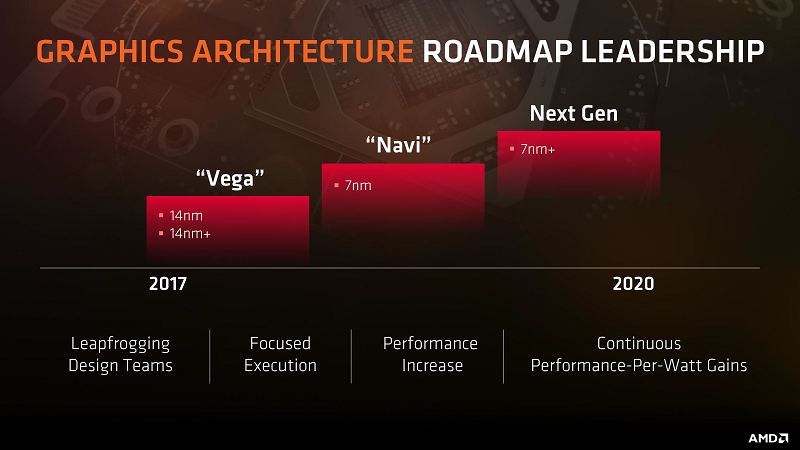AMD's Navi Rumored to Launch at E3 2019
AMD’s rumor mill, it definitely be a turning. According to Red Gaming Tech and OC3D AMD’s delayed Navi architecture could be launching as early as July this year. Indeed with Lisa Su announcing that: “you will hear more about Navi in 2019,” multiple sites are now reporting on a new source who’s suggesting that the company is very happy with the outcome of Navi so far, and expecting an announcement at E3 this year, followed by a hard launch one month later.
Based off of the TSMC’s 7nm architecture debuted at CES with the Radeon VII, Navi is supposedly aimed at the low-mid range GPU portion for now, designed to tackle the likes of the GTX 1070 Ti/RTX 2060 respectively. What is surprising about this rumor is there’s no mention of a high-end Navi variant until early 2020, suggesting that Navi as a whole is a replacement for the now aging, and much refreshed Polaris graphics architecture.
Looking back at the original notes we have from AMD on Navi’s architecture, the big key word that keeps popping up is its “scalability”, although there’s no actual confirmation on what that exactly means, whether it’s a multi-die chip similar to Ryzen, or just a better scaling architecture than GCN’s max 4,096 stream processor limitation, it’s an exciting prospect to see AMD break down that artificially imposed barrier, and opens up a lot of options for the company.
If this is true, it should give the Radeon VII a healthy-ish shelf life, and at least give the company a chance to stymie the oncoming tide of Nvidia’s high-end flagship GPUs, at least for the time being.
The big mystery now is going to be how exactly Navi will fit into the lineup. We know Arcturus, Navi’s successor should be launching some time in 2020 as well, as a true high-end successor. Yet Navi itself is being labelled as AMD’s prodigal son. Is it purely because of it circumventing GCN’s limitations? Who knows. If I were a betting man, and I’m afraid to say I am, I’d put my money on Navi being a true new architecture 7nm test, with the following Arcturus cards being enterprise oriented, followed by a big Navi, high-end flagship in 2020 with a 7nm+ refresh.
Get Tom's Hardware's best news and in-depth reviews, straight to your inbox.

As Associate Editor of Tom's Hardware's prestigous British division, Zak specializes in system building, case reviews and peripherals, and has a particular penchant for liquid-cooling. He's also a lover of all things Viking/Scandinavian (thus the poor attempt at a beard).
-
Supahos Shaping up to be an interesting "middle of 2019" for AMD.Reply
If nothing else the landscape of gaming pcs will be drastically different overall by Christmas between ryzen 3000/Vega 7/Navi/ Intel 10nm cpus -
TCA_ChinChin My hype for AMD's new CPUs and GPUs is immeasurable right now, but I'm afraid for that exact same reason.Reply -
redgarl One thing for sure, we will know if the leaks from AdoredTV are true at some point this year.Reply
If AMD can match Vega 64 + 5-10% performances for 250-275$, than the whole RTX series will be in deep trouble. -
tim.hotze AMD is really becoming a "tale of two companies." On one hand, they've executed on their Zen/Ryzen roadmap like clockwork since 2017, and they were touting their performance/watt efficiency advantage over Intel at CES.Reply
On the other, their GPU releases look NOTHING like that chart: They never released a "14nm+" (probably TSMC 12nm) Vega GPU, but they DID release a 12nm Polaris GPU (not on the chart) and a 7nm Vega GPU (the Radeon VII and the Instinct that it's based on, also not on that chart). We'll see what Navi brings, but given that there basically no rumors on Radeon VII, I wonder how accurate the Navi rumors are. It's been a very, very long time since anyone's released a GPU that targeted the middle before going for the high end.
If I had to make a bet, I'd guess that Navi is 7nm Vega with a GDDR memory controller to keep prices down. AMD has tons of experience mixing and matching GPU features with its semi-custom business (Kaby Lake-G's Radeon, for example), so it seems like something they could do without too much effort. They MIGHT add ASICs for raytracing as Nvidia did, or they might not.
That means the 2020 release would be a new (post-GCN) architecture that would probably start at the high end before working its way down (just as we've traditionally seen from Nvidia and AMD). -
JamesSneed AMD has been very tight lipped with Navi so I really expect they have something special with Navi. I really hope they surprise us as we desperately need competition back in the GPU space.Reply -
InvalidError Reply
Nothing too special: you have ~3X the transistor density on 7nm that you had at 14nm, so you can cram twice the processing power in 40-50% less space depending on the frequency bump and architectural efficiency gains, which means you should be able to provide roughly twice the performance at every price point if you wanted to.21690903 said:AMD has been very tight lipped with Navi so I really expect they have something special with Navi.
Assuming Navi is a decent improvement over Polaris and Vega on performance and efficiency, how much of a success Navi will be will hinge largely on how much of the savings from increased performance per die area AMD and its AIB partners decide to pass on to the end-users.
-
InvalidError Reply
Intel's 10nm in its original form had ~2.7X the density of its 14nm+++ so yes, ~3X for TSMC's 7nm vs AMD's other fabs-for-hire's less mature 12/14/16nm should be a reasonable approximation.21691626 said:You don't get 3x the transistor density, it doesn't work that way.
-
bulldogg18 Don't they normally do big reveals at Computex? I don't remember the last time AMD debuted something at E3, if you don't count consoles as an AMD release.Reply

